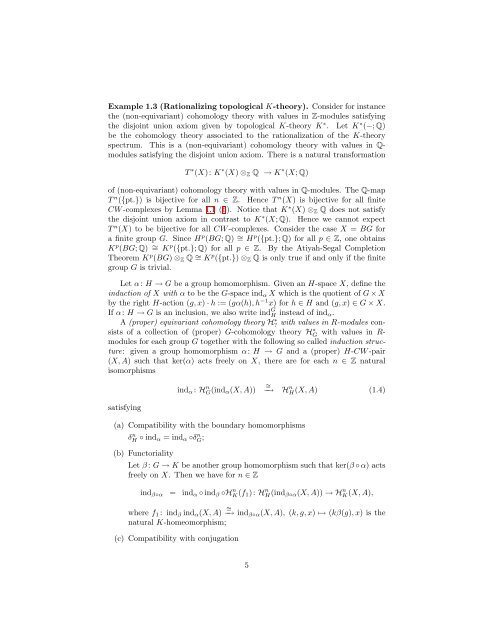Equivariant Cohomological Chern Characters
Equivariant Cohomological Chern Characters
Equivariant Cohomological Chern Characters
You also want an ePaper? Increase the reach of your titles
YUMPU automatically turns print PDFs into web optimized ePapers that Google loves.
Example 1.3 (Rationalizing topological K-theory). Consider for instancethe (non-equivariant) cohomology theory with values in Z-modules satisfyingthe disjoint union axiom given by topological K-theory K ∗ . Let K ∗ (−; Q)be the cohomology theory associated to the rationalization of the K-theoryspectrum. This is a (non-equivariant) cohomology theory with values in Q-modules satisfying the disjoint union axiom. There is a natural transformationT ∗ (X): K ∗ (X) ⊗ Z Q → K ∗ (X; Q)of (non-equivariant) cohomology theory with values in Q-modules. The Q-mapT n ({pt.}) is bijective for all n ∈ Z. Hence T n (X) is bijective for all finiteCW -complexes by Lemma 1.1 (b). Notice that K ∗ (X) ⊗ Z Q does not satisfythe disjoint union axiom in contrast to K ∗ (X; Q). Hence we cannot expectT n (X) to be bijective for all CW -complexes. Consider the case X = BG fora finite group G. Since H p (BG; Q) ∼ = H p ({pt.}; Q) for all p ∈ Z, one obtainsK p (BG; Q) ∼ = K p ({pt.}; Q) for all p ∈ Z. By the Atiyah-Segal CompletionTheorem K p (BG) ⊗ Z Q ∼ = K p ({pt.}) ⊗ Z Q is only true if and only if the finitegroup G is trivial.Let α: H → G be a group homomorphism. Given an H-space X, define theinduction of X with α to be the G-space ind α X which is the quotient of G × Xby the right H-action (g, x) · h := (gα(h), h −1 x) for h ∈ H and (g, x) ∈ G × X.If α: H → G is an inclusion, we also write ind G H instead of ind α .A (proper) equivariant cohomology theory H? ∗ with values in R-modules consistsof a collection of (proper) G-cohomology theory HG ∗ with values in R-modules for each group G together with the following so called induction structure:given a group homomorphism α: H → G and a (proper) H-CW -pair(X, A) such that ker(α) acts freely on X, there are for each n ∈ Z naturalisomorphismsind α : H n G(ind α (X, A))∼ =−→ H n H(X, A) (1.4)satisfying(a) Compatibility with the boundary homomorphismsδ n H ◦ ind α = ind α ◦δ n G ;(b) FunctorialityLet β : G → K be another group homomorphism such that ker(β ◦ α) actsfreely on X. Then we have for n ∈ Zind β◦α = ind α ◦ ind β ◦H n K(f 1 ): H n H(ind β◦α (X, A)) → H n K(X, A),where f 1 : ind β ind α (X, A) ∼= −→ ind β◦α (X, A), (k, g, x) ↦→ (kβ(g), x) is thenatural K-homeomorphism;(c) Compatibility with conjugation5
















